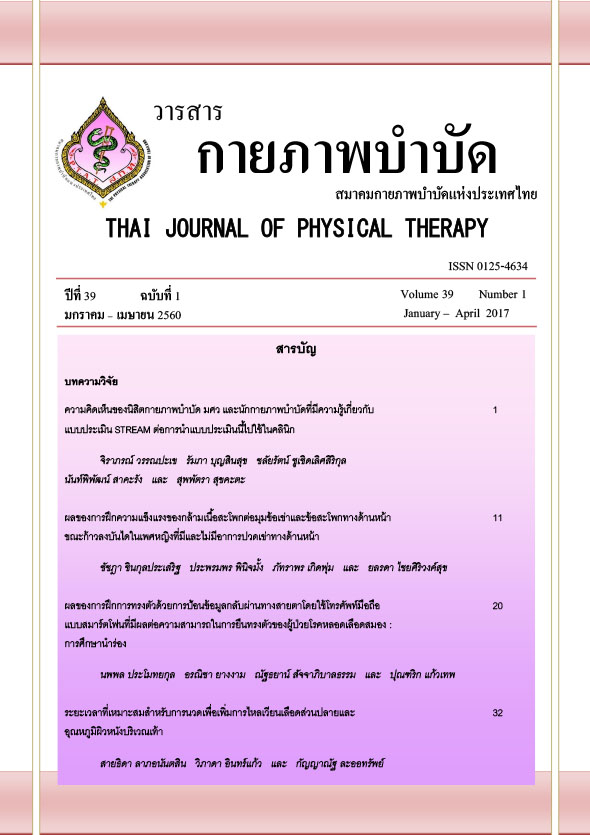ระยะเวลาที่เหมาะสมสำหรับการนวดเพื่อเพิ่มการไหลเวียนเลือดส่วนปลายและ อุณหภูมิผิวหนังบริเวณเท้า
Main Article Content
บทคัดย่อ
ที่มาและความสำคัญ: การนวดเป็นวิธีการรักษาชนิดหนึ่งที่ได้รับความนิยมในการเพิ่มการไหลเวียนเลือดส่วนปลาย อย่างไรก็ตาม ไม่พบการศึกษาใดระบุชัดเจนถึงระยะเวลาที่เหมาะสมของการนวดที่เพิ่มการไหลเวียนเลือดส่วนปลาย
วัตถุประสงค์: เพื่อศึกษาผลทันทีของการนวดที่ขาและเท้า ณ ระยะเวลาต่างๆ ต่อการไหลเวียนเลือดส่วนปลายและอุณหภูมิผิวหนังบริเวณเท้า
วิธีการ: รูปแบบการวิจัยคือ time series research design โดยวิจัยในกลุ่มอาสาสมัครหนุ่มสาวสุขภาพดี 30 คน อายุเฉลี่ย 21.97 ± 1.07 ปี ได้รับการนวดแบบสวีดิชที่บริเวณปลายขาและเท้าด้านขวาเป็นเวลา 40 นาที ในห้องควบคุมอุณหภูมิที่ 24-26 องศาเซลเซียส ค่าตัวแปรที่ต้องการศึกษา ก่อนและหลังได้รับการนวดทุก 10 นาที ได้แก่ ค่าความดันโลหิตที่เส้นเลือดแดงบริเวณข้อเท้าdorsalis pedis (aSBPd) และ posterior tibial (aSBPp) ค่าดัชนีความดันโลหิตบริเวณข้อเท้าเมื่อเทียบกับแขน (ABI) และอุณหภูมิผิวหนังบริเวณเท้า (T) การวิเคราะห์ข้อมูลทางสถิติของค่า ABI และ T ใช้ One-way repeated measures ANOVA และการทดสอบ Bonferroni ส่วนค่า aSBPd และ aSBPp วิเคราะห์ด้วยการทดสอบ Friedman และการทดสอบ Wilcoxon signed rank
ผลการศึกษา: พบว่าระยะเวลาการนวดมีผลอย่างมีนัยสำคัญต่อค่า aSBPd (p = 0.001), aSBPp (p = 0.024) และ ค่า ABI (p = 0.002) แต่ไม่มีผลต่ออุณหภูมิผิวหนังบริเวณเท้าโดยพบว่าค่า aSBPd และ aSBPp ณ เวลา 20, 30 และ 40 นาที หลังนวดสูงกว่าก่อนการนวดอย่างมีนัยสำคัญ( p <0.01) และพบว่าค่า ABI ณ เวลา 20 และ 30 นาทีเท่านั้น ที่มีค่าสูงกว่าก่อนได้รับการนวดอย่างมีนัยสำคัญทางสถิติ (p<0.01)
สรุปการศึกษา: การนวดขาและเท้า(อย่างไม่ต่อเนื่องโดยมีการหยุดเป็นระยะทุก 10 นาที) เป็นระยะเวลาตั้งแต่ 20 นาทีขึ้นไปอาจส่งผลเพิ่มการไหลเวียนเลือดส่วนปลายสู่บริเวณเท้า โดยการเพิ่มความต่างของแรงดันภายในหลอดเลือดแดงและหลอดเลือดดำ
Article Details
เอกสารอ้างอิง
2. Lind L, Lithell H. Decreased peripheral blood flow in the pathogenesis of the metabolic syndrome comprising hypertension, hyperlipidemia, and hyperinsulinemia. Am Heart J 1993;125(5):1494-7.
3. Cheing GL-Y, Sun J, Kwan RL-C, Zheng Y. The potential influence of diabetic history on peripheral blood flow in superficial skin. Microvasc Res 2013; 90: 112–6.
4. Cunningham JE, Kelechi T, Sterba K, Barthelemy N, Falkowski P, Chin SH. Case report of a patient with chemotherapy-induced peripheral neuropathy treated with manual therapy (massage). Support Care Cancer 2011; 19: 1473-6.
5. Kim JO, Kim IS. Effects of aroma self-foot reflexology massage on stress and immune responses and fatigue in middle-aged women in rural areas. Journal of Korean Academy of Nursing 2012; 42: 709-18.
6. .Aourell M, Skoog M, Carleson J. Effects of Swedish massage on blood pressure. Complement Ther Clin Pract 2005; 11: 242-6.
7. Ejindu A. The effects of foot and facial massage on sleep induction, blood pressure, pulse and respiratory rate: crossover pilot study. Complement Ther Clin Pract 2007; 13: 266-75.
8. Lapanantasin S, Songkhropol Y, Ritsamret N, Jamjuree S. Immediate effects of massage, Buerger-Allen exercise and weight bearing exercise on peripheral blood flow and skin temperature of foot in young adults. Thai Journal of Physical Therapy 2016; 38: 14-22. (In Thai)
9. WOCN® Clinical Practice Wound Subcommittee, 2005 Updated/Revised: WOCN® Wound Committee, 2010-2011. Ankle brachial index: quick reference guide for clinicians. J Wound Ostomy Continence Nurs 2012; 39 (2 Suppl): S21-9.
10. Boonsinsukh P. Manual therapy. Bangkok: SP Printing. 2009. (In Thai)
11. Nelson NL. Massage therapy: understanding the mechanisms of action on blood pressure: a
scoping review. J Am Soc Hypertens 2015; 9: 785-93.
12. Diego MA, Field T. Moderate pressure massage elicits a parasympathetic nervous system response. Int J Neurosci 2009; 119: 630-8.
13. Cassar M-P. Handbook of massage therapy: a complete guide for the student and professional massage therapist. Oxford; Boston: Butterworth-Heinemann; 1999.
14. Goats GC. Massage--the scientific basis of an ancient art: part 2 physiological and therapeutic effects. Br J Sports Med 1994; 28:153-6.
15. Kunikata H, Watanabe K, Miyoshi M, Tanioka T. The effects measurement of hand massage by the autonomic activity and psychological indicators. J Med Invest 2012; 59(1-2): 206-12.
16. Eguchi E, Funakubo N, Tomooka K, Ohira T, Ogino K, Tanigawa T. The effects of aroma foot massage on blood pressure and anxiety in Japanese community-dwelling men and women: a crossover randomized controlled trial. PLoS One 2016; 11(3): e0151712.


